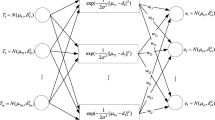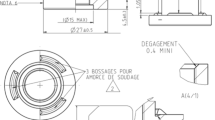Abstract
The application of finite element method and intelligent systems techniques to predict the applied force during the radial forging process is studied. Radial forging is a unique process used for the precision forging of round and tubular components, with or without an internal profile. More than 800 radial forging machines are currently operating worldwide. Since the maximum forging force per die is constant, determining the die force before the process can prevent die damage and material wastage. Then, the results of the FE simulation are applied for two intelligent forecasting systems in artificial neural network and adaptive neuro-fuzzy inference system. Initial billet temperature, die inlet angle, feed rate, and reduction in cross-section are applied as input parameters, and radial forging force is applied as the output parameter. Finally, the results of these two intelligent systems are compared with the multiple regressions method. A sensitivity analysis is carried out to determine how the radial forging force is influenced by the input parameters.












Similar content being viewed by others
Explore related subjects
Discover the latest articles, news and stories from top researchers in related subjects.References
Jang JSR, Sun CT, Mizutani E (1997) Neuro-fuzzy and soft computing. Prentice Hall, USA
Fuller R (2000) Introduction to neuro-fuzzy systems. Physica Verlag, Heidelberg, New York
Maji K, Pratihar DK, Nath AK (2014) Laser forming of a dome shaped surface: experimental investigations, statistical analysis and neural network modeling. Opt Lasers Eng 53:31–42
Abbassi F, Belhadj T, Mistou S, Zghal A (2013) Parameter identification of a mechanical ductile damage using artificial neural networks in sheet metal forming. Mater Des 45:605–615
Elangovan K, Sathiya Narayanan C, Narayanasamy R (2010) Modeling of forming limit diagram of perforated commercial pure aluminum sheets using artificial neural network. Comput Mater Sci 4:1072–1078
Golestanian H, Poursina M (2009) Neural network analysis application to permeability determination of fiberglass and carbon performs. Chin J Polym Sci 27:221–229
Gudur PP, Dixit US (2008) A neural network-assisted finite element analysis of cold flat rolling. Eng Appl Artif Intell 21:43–52
Belfiore NP, Ianniello F, Stocchi D, Casadei F, Bazzoni D, Finzi A, Carrara S, Gonzaález JR, Lianos JM, Heikkila I, Peñalba F, Gómez X (2007) A hybrid approach to the development of a multilayer neural network for wear and fatigue prediction in metal forming. Tribol Int 40:1705–1717
Zhu ZX, Torisu R, Takeda JI, Mao ER, Zhang Q (2005) Neural network for estimating vehicle behavior on sloping terrain. Biosyst Eng 91(4):403–411
Malekzehtab H, Golafshani AA (2013) Damage detection in an offshore jacket platform using genetic algorithm based finite element model updating with noisy modal data. Proc Eng 54:480–490
Yang JM, Che HJ, Dou FP, Zhou T (2008) Genetic algorithm based optimization used in rolling schedule. Iron Steel Res 15:18–22
Kadkhodaei M, Salimi M, Poursina M (2007) Analysis of asymmetrical sheet rolling by a genetic algorithm. Mech Sci 49:622–634
Poursina M, Antonio C, Castro CF, Parvizian J, Sousa LC (2004) Preform optimal design in metal forging using genetic algorithms. Eng Comput 21:631–650
Chen B, Matthews P, Tavner P (2013) Wind turbine pitch faults prognosis using a priori knowledge-based ANFIS. Expert Syst Appl 40:6863–6876
Özger M, Yıldırım G (2009) Determining turbulent flow friction coefficient using adaptive neuro-fuzzy computing technique. Adv Eng Softw 40:281–287
Wei M, Bai B, Sung A, Liu Q, Wang J, Cather M (2007) Predicting injection profiles using ANFIS. Inf Sci 177:4445–4461
Yeh FH, Lu YH, Li CL, Wu MT (2006) Application of ANFIS for inverse prediction of hole profile in the square hole bore-expanding process. Mater Process Technol 173:136–144
Oreski S, Oreski G (2014) Genetic algorithm-based heuristic for feature selection in credit risk assessment. Expert Syst Appl 41:2052–2064
Rezaeian Zeidi J, Javadian N, Tavakkoli-Moghaddam R, Jolai F (2013) A hybrid multi-objective approach based on the genetic algorithm and neural network to design an incremental cellular manufacturing system. Comput Ind Eng 66:1004–1014
Das P, Mukherjee S, Ganguly S, Bhattacharyay BK, Datta S (2009) Genetic algorithm based optimization for multi-physical properties of HSLA steel through hybridization of neural network and desirability function. Comput Mater Sci 45:104–110
Son JS, Lee DM, Kim IS, Choi SK (2004) A study on genetic algorithm to select architecture of optimum neural network in hot rolling process. Mater Process Technol 153–154:643–648
Samanta B (2004) Artificial neural networks and genetic algorithms for gear fault detection. Mech Syst Signal Process 18:1273–1282
Khayatzadeh S, Poursina M, Golestanian H (2008) 3-D finite element modeling of a hot radial forging process. Steel Res Int 79:576–583
Abedian A, Poursina M, Golestanian H (2007) A comparison between the properties of solid cylinders and tube products in multi-pass hot radial forging using finite element method. In: NUMIFORM07, vol 908, pp 963–968
Rumelhart DE, Hinton GE, Williams RJ (1986) Learning representations by back-propagating errors. Nature 323(6088):533–536
Yeung D, Cloete I, Shi D, Ng WWY (2010) Sensitivity analysis for neural networks. Springer, Heidelberg
Math Works Inc (2009) Matlab User Manual. Version 7.8 (R2009a)
Zadeh LA (1965) Fuzzy algorithms. Inform Control 12:94–102
Jang JR (1993) ANFIS: adaptive-network-based fuzzy inference system. IEEE Trans Syst Man Cybern 23:665–684
Author information
Authors and Affiliations
Corresponding author
Rights and permissions
About this article
Cite this article
Azari, A., Poursina, M. & Poursina, D. Radial forging force prediction through MR, ANN, and ANFIS models. Neural Comput & Applic 25, 849–858 (2014). https://doi.org/10.1007/s00521-014-1562-8
Received:
Accepted:
Published:
Issue Date:
DOI: https://doi.org/10.1007/s00521-014-1562-8




